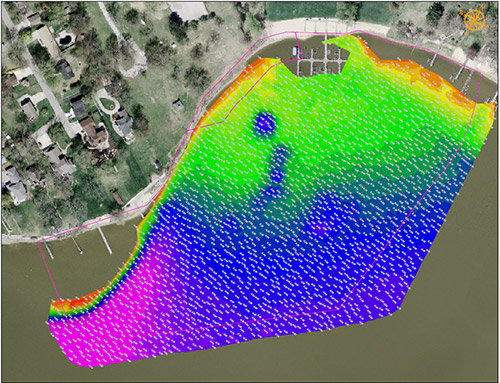Singlebeam and SideScan Survey to Identify Sediment Buildup
A 21’ survey vessel was deployed from a marina on an inland lake in the Midwestern United States to survey an area set forth as the proposed study area to Hibbard Inshore. Survey data was collected using a single beam echosounder and two forms of side scan sonar. Attempts to collect data were also made with 2 separate frequencies of a sub-bottom profiling sonar.
There were approximately 45 data lines run 10 feet apart from one another covering approximately 1000 in linear distance to give an accurate representation of depth of the survey area. Prior to the survey, as part of the mobilization, these track lines were plotted into a navigation system on the boat, and the operator followed them in real-time during the survey. The survey was performed in calm water conditions to achieve the requested .15 foot depth accuracy, and the survey speed was kept to approximately .7 knots due to the shallow water. A bar test was performed prior to the inspection to calibrate the sensor, and both pre and post survey tests were performed each day to ensure that the sonar unit and positioning was accurate. The frequency of the sonar that was used was 200 kHz, and the data recorded was first return at that frequency.
 Singlebeam Survey Color Shaded Relief
Singlebeam Survey Color Shaded Relief
The 2 man survey crew consisting of one hydrographic surveyor (supervisor-level, ACSM-certified hydrographer) and one boat operator and safety spotter arrived onsite and proceeded to use the Knudsen 3212 Chirp Echosounder to attempt to gather both 200 kHz singlebeam bathymetric sonardata as well as 28 kHz sub-bottom profiler data. Geographic positioning was provided via Real-Time Kinematic GPS receiving corrections from the local reference station network. After significant attempts to adjust sonar performance for the sub-bottom profiling effort, it was determined that it was difficult to get any kind of reflector to show up beneath the mudline with the sub-bottom profiler. Because of this, the survey team switched over to take the side scan sonar that day in order to allow them to re-attempt the sub-bottom profiles the following day with modified gain settings. The Tritech Starfish was used successfully to collect sidescan data.

